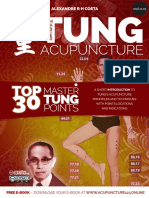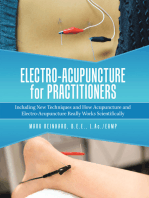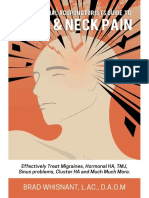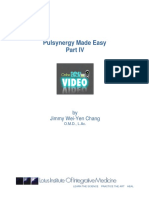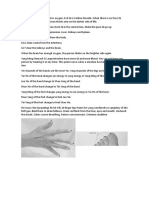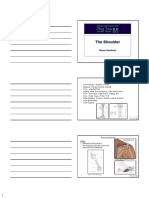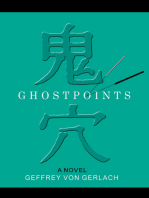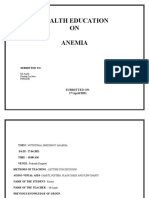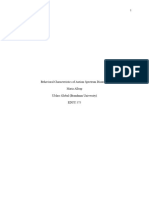Scalp Acupuncture Theory and Clinical Applications: Yuxing Liu
Scalp Acupuncture Theory and Clinical Applications: Yuxing Liu
Uploaded by
itsik12886Copyright:
Available Formats
Scalp Acupuncture Theory and Clinical Applications: Yuxing Liu
Scalp Acupuncture Theory and Clinical Applications: Yuxing Liu
Uploaded by
itsik12886Original Description:
Original Title
Copyright
Available Formats
Share this document
Did you find this document useful?
Is this content inappropriate?
Copyright:
Available Formats
Scalp Acupuncture Theory and Clinical Applications: Yuxing Liu
Scalp Acupuncture Theory and Clinical Applications: Yuxing Liu
Uploaded by
itsik12886Copyright:
Available Formats
Scalp Acupuncture Theory
and clinical Applications
Yuxing Liu
Academy of Oriental Medicine at Austin
General introduction
Conception
Scalp acupuncture is a therapeutic method by needling the
specific areas or lines of the scalp, and often used to treat
cerebral diseases.
Introduction
Scalp acupuncture: 2 schools,and
2 system
School-A. Theory base:cerebral physiology and anatomy
Dr.Jiaos
scalp acupuncture,Fangs
and Zhus Scalp
acupuncture. Began in 1958 and popularized in 1970s
School-B. Based on Meridian theory and acupoints on the
head.
International standard scalp line
Began in 1958 and popularized in 1970s
Founder: Dr. Jiao, Shunfa, MD of Shanxi
province
Dr. Fang, Yunpeng, MD
History of Jiaos Scalp Acupuncture
Base of Traditional Scalp
Acupuncture
1. Front-mu & Back-Shu treating Zang-fu
organs
2. Selecting Local points
3. Relationship between Head and Channels
All Yang Channels go to the head
Yin Channels: HT, LIV
4. Relationship between brain and qi &
blood(zangfu)
5. Crossing phenomenon of meridian system
Different Areas of Brain
Functional Areas of the
Cerebral Cortex
The different central area in the brain
controls the different body areas functions
They have the corresponding reflex area or
line on the scalp
Motor area
Anatomic structure:
Precentral gyrus, Paracentral lobule
Physiology
control muscular contraction on the
opposite side, but Extraocular
muscles,frontal muscles, masticatory
muscles of both sides
Reflex image
upside down, but face is upright
Sensory area
Anatomic structure:
postcentral gyrus,
post side of Paracentral
lobule
Physiology:
feeling the nerve pulses
coming from the
correspondent area of
the opposite side
Speech area
Wernickes
area: Sensory
speech(3
rd
)
Brocas area:
Motor speech(1
st
)
Angular gyrus:
anomic speech(2
nd
)
Aphasia:
Absent or defective
speech or
language
comprehension
Visual Area
Occipital lobe: Visual
Medial surface: primary
visual cortex (striate cortex)
input: thalamus (lateral
geniculate nucleus)
contralateral
representation
Rest: visual association cortex:
interpretation of visual stimuli
Location of Stimulating Scalp
areas and their indications
Standard lines on
the scalp
Anterior-posterior
midline
Eyebrow-occipital line
Anatomical
landmark
Ear apex,
parietal tubercle
external occipital
protuberance
Frontal hair line (or angle)
Motor Area
Locations:
1. Upper point
2. Lower point
Indications:
upper 1/5: lower limbs, trunk; For paralysis of the opposite side
middle 2/5: upper limbs; For paralysis of the opposite side
lower 2/5: facial area or Speaking Area 1; For contralateral central
facial paralysis; Motor aphasia, salivation and dysphonia.
Sensory Area
Locations:
the parallel line 1.5 cm behind to motor area
Indications:
upper 1/5: lower limbs, trunk, posterior head and neck; For contralateral
lumbar, leg pain, numb, paralysis; occipital headache, pain in the nape area;
tinnitus
middle 2/5: upper limbs; For contralateral upper limb pain, numbness,
paralysis, abnormal senses
lower 2/5: facial area; For contralateral facial numbness, migraine, TMJ ;
trigeminal neuralgia, toothache.
Chorea-trembling Controlled Area
Locations:
the parallel line 1.5cm anterior to
motor area
Indications:
Chorea, Parkinsons disease;
trembling palsy
If the symptom is unilateral,
needle the contra-lateral
stimulation area.
If bilateral needle bilaterally
Vascular dilation & Constriction Area
Locations:
the parallel line 1.5cm
anterior to chorea &
tremor controlling area
Indications:
To treat essential
hypertension and cortical
edema
Vertigo-auditory Area
Locations:
2 cm anterior and posterior
horizontal straight to the points 1.5
cm right above the auricular apex
Indications:
Tinnitus, hearing losing,
dizziness, auditory
vertigo, etc.
Speaking area 3
Locations:
1. midpoint of Vertigo-auditory
area draw a line of 4 cm
backwards
2. 4 cm horizontal posterior to
the point 1.5 cm above the ear
apex
Indications:
Sensory aphasia
Speech area 2
Locations:
2cm- posterior+inferior
parietal tubercle draw a
3cm-long line, paralleled to
anterior-posterior midline
Indications:
nominal aphasia
Usage area
Locations:
Taking the parietal tubercle as a starting
point. Draw a vertical line from the point,
and draw the other two lines from the
point separately forwards and back
wards, at 40 degree angle with the
vertical line; each line is 3 cm long.
Indications:
Apraxia (normal muscular tension, but
disability to finish refined movement
such as picking up coins)
Foot motor-sensory area
Locations:
starting from 1cm bilateral to midpoint of
anterior-posterior midline draw two
line 3 cm straight lines backward parallel to
the anterior-posterior midline
Indications:
Contralateral lower limb pain, paralysis,
numbness.
acute lumbar sprain;
enuresis, cerbro-cortical polyuria, nocturia;
prolapse of uterus.
Optic area
Locations:
1 cm evenly bilateral to the
external occipital protuberance,
draw 4 cm long lines upwards
parallel to the anterior-
posterior midline.
Indications:
Cerebro-cortical visual
disorders
Balance area
Locations: 3.5 cm evenly
bilateral to the external occipital
protuberance, draw a 4 cm long lines
downwards parallel to the anterior-
posterior midline.
Indications:
Equilibrium disturbance caused by
cerebellum disease.
(Incoordination; dystaxia; ataxia,
disability to balance, dizziness,
headache )
Locations:
Directly above pupil of eyes,
draw 2 cm line upwards from
the hairline,
Indications:
Stomach pain (gastritis,
stomach ulcer) epigastric discomfort.
Stomach area
Location:
mid point between front-back midline and
stomach area, draw a line of 2 cm
upwards and downwards from the hair
margin
Indications:
Chest pain, stuffiness of chest
Palpitation, coronary artery insufficiency
Asthma
Thoracic Area
Location:
Draw a 2 cm straight line from the front
angle (ST8) upward parallel to the
anterior-posterior midline
Indications:
Dysfunctional uterine bleeding,
Pelvic inflammation;
Leukorrhagia
To treat prolapse of uterus with Foot
motor sensory area
Reproductive area
The Principle for selecting
scalp area
Selecting the stimulating area according to different
diseases;
Using the contra lateral stimulating area for the
unilateral limbs diseases; the bilateral stimulating
areas for bilateral limbs disorders.
Internal-zang or whole body diseases, diseases can
not distinguish the position, bilateral sides could be
selected.
Accompany with other related stimulating area.
Needling Techniques
1.Posture
Sitting or lying position
2.Inserting needle
Clean local area,
1-2cun, Gauge No.28-32.
Swiftly insert the needle at a 30
degree angle to the scalp,gets to
the lower layer of cap-shaped
aponeurosis
Then push the needle along the
direction of stimulation to the
needed depth.
3.Needle manipulation
Only twirling no thrusting
Fix the needle at the same depth
Frequency: about 200/minute, continue 1-2 minute, keep
the needle for 5-10 minutes, repeat stimulation 2-3 times.
4E-stim
Frequency:200-300/minute (high frequency)
Wave:refer to electro-acupuncture
Stimulating intensity:based
on patients reaction
Taking off needle
Withdraw the needle slowly while twirling the needle;
if there is no heavy sensation along the needle pull it
out quickly.
Then press over the needle hole with a clean dry
cotton ball for a moment to prevent bleeding
Treatment course
Once a day or every two days. (twice a week in America)
10 times as one treatment course.
Precautions
1.The stimulating intensity should be suitable;lying or sitting
position should be taken to prevent needle fainting.
2.Strict sterilization should be carried out to prevent infection.
3.If the operator feels the needling resistance or the patient feels
pain while pushing the needle, the needle should be withdrawn a
little bit, then change the direction.
4. In case the patient has such a complication as high fever, acute
inflammations or heart failure, scalp acupuncture is not advisable.
5. For patients with hemi-paralysis due to cerebral hemorrhage,
wait until the bleeding stops and the condition is stable to use
scalp acupuncture. But for case caused by cerebral thrombosis
should use scalp acupuncture as early as possible.
Clinical Applications
Mainly for Nervous Diseases, especially
for cerebral diseases , like cerebral thrombosis,
cerebral hemorrhage causing paralysis, numbness,
aphasia
Various nerve pain like trigeminal neuralgia,
sciatic pain.
Other common diseases, like lumbar-leg pain,
Frozen shoulder, nocturnal urine.
Diseases of Nervous system
Cerebrovascular Diseases
Cerebral Thrombosis
Time: The shorter the case history, the better the
therapeutic result.
Location of thrombosis and therapeutic effect
Severity of limb paralysis and therapeutic effect
Cerebral Hemorrhage
2 types: hemorrhage of internal capsule (basal
ganglia), hemorrhage of cortical branches of the
cerebral artery.
Clinical course: applying scalp acupuncture at an
earlier date after the patients condition becomes
stable can produce a better therapeutic result
Location of bleeding:
Cerebral Embolism
Motor area, sensory area, foot motor & sensory
area
Diseases of Peripheral Nerves
Facial paralysis (Bells Palsy): lower 2/5 of motor area
Herpes zoster: Sensory area, foot motor & sensory area
Neuralgia Sciatica: upper 2/5 of sensory area, foot motor &
sensory area
Headache
Top headache: upper 2/5 of sensory area
Frontal and temple headache: lower 2/5 of the sensory
area
Hypertension
Upper half of the vascular dilation & constriction area (both
sides)
International
Standard Scalp
Acupuncture
History and Characters
1984 Tokyo WHO
Principle:
1.Define the channel in different area,
2. select points on the channel,
3. combining ancient threading techniques
Name:
MS (Micro-system and Scalp points )+Number; Chinese
Pinyin and Chinese
Frontal Head Area
MS1 (e-zhong-xian) Middle line of forehead
Location:on the front head, 1 cun(3cm) long line from Du24, straight
down along the meridian
Indication:Headache, dizziness, red swollen and pain of the
eyes, epilepsy; mental disorder
Needling Method:needling downward subcutaneouly,
manipulate the needle swiftly
MS2 (E-pang-Xian-I) Lateral line 1 of forehead
Thoracic area
Location
on the front head, 1 cun(3 cm) long from BL3, straight
down along the meridian
Indication
Lung system disorders: allergic asthma, bronchitis;
Heart System disorders: angina pectoris,heart
diseases.Palpitation, flustered
Needling Method
needling from BL3 downward subcutaneouly,
manipulate the needle swiftly
MS3 (E-pang-Xian-II) Lateral line 2 of forehead
[Stomach
area, Liver & Gallbladder Area]
Location
on the front head, 1 cun(3 cm) long from GB15
, straight down
along the meridian
Indication
Digestive disorders
acute & chronic gastritis, gastroduodenal
ulcer;gastrointestinal ulcer. diarrhea or constipation,dysentery.
Liver & Gallbladder disordersHepatitis, cholecystitis
Needling Method
needling from GB15
downward subcutaneouly, manipulate the
needle swiftly
MS4 (E-pang-Xian-III) Lateral line 3 of forehead
Location
on the front head, 1 cun(3 cm) long from the point 0.75 cun
medial to ST8 straight down.
Between GB and ST channels
Indications
Reproductive system disordersfemaleDysfunction
uterine bleeding, Prolapse
of uterus, dysmenorrhea,
Amenorrhea, irregular menstruation
Male
Impotence, Spermatorrhea; Seminal emission,
premature ejaculation
Urine system disorders
acute cystitis(urinary
frequencyurgency of urination). polyuria
Needling Method
needling from the upper border of this line downward subcutaneously,
manipulate the needle swiftly
Vertex area
MS5 (Dingzhongxian)
Location
From Du20 to Du21 along the midline of head
Indications
Local:headache, dizziness, hypertension
Mental disordersfaint, syncope, asphyxia; mania; epilepsy, aphasia from
apoplexy, insomnia
Lumbar and leg pain, numbness, or paralysis
Two lower orifices disorderscerebral-cortical polyurianocturia (infant),
prolapse of anus
Needling Method:inserting needle from Du20, needling to DU21
subcutaneous, manipulate the needle swiftly
MS6 (Dingnieqianxiexian) Anterior oblique line of vertex
temporal
[motor area]
Location
From qian shenchong (anterior point of sishenchong)
obliquely to GB6, divided into 5 parts.
Indications;Needling Method
Same as motor area
MS7 (DingnieHouxiexian) Posterior oblique line of vertex
temporal
[Sensory area]
Location
From Du20 obliquely to GB7, divided into 5 parts.
Indications;Needling Method
Same as sensory area
MS8 (Dingpanyixian) Lateral line 1 of vertex
Location
1.5cun lateral to middle line of vertex, 1.5 cun long from BL7 backward
along the meridian
Indications
Localheadache,dizziness, tinnitus, blurred vision
Lumbar & leg disorders: paralysis, numbness, pain
Needling Method
From BL7 needling posterior 1.5 cun subcutaneously,
manipulate the needle quickly
MS9 (DingpanEr xian) Lateral line 2
of vertex
Location
2.25 cun long lateral to middle line of vertex, 1.5 cun long from
GB17 backward along the meridian
Indications
Localheadache,dizziness, migraine
Shoulder, arm & hand disorders: paralysis, numbness, pain
Needling Method
From GBL7 needling posterior 1.5 cun subcutaneously,
manipulate the needle quickly
Temporal Area
MS10 (Nie Qian xian) Anterior temporal line
Location
From GB4 to GB6
Indications
Head & facial disordersmigraine, outer canthus pain, tinnitus, epilepsy, motor
aphonia, peripheral facial paralysis;oral cavity disordersgingivitis,tonsillitis);
Throat disorders
Needling Method
Inserting from GB4 needling to GB6 subcutaneously, manipulate the needle
quickly
MS11 (Nie Hou xian) Posterior temporal line
Location
From GB8 to GB7
Indications
Head & facial disordersmigraine, tinnitus, deafness
Needling Method
Inserting from GB8 needling to GB7 subcutaneously, manipulate the needle
quickly
Occipital area
MS12 (Zhenshangzhengzhongxian )
Location
From Du18 to Du17
Indications
LocalOccipital headache, dizziness, blurred vision, stiff neck
Mental disorders:Epilepsy, mania-depression
Eyes disorderskeratitisconjunctivitis
tinea
pedis; athletes foot; hongkong
foot
Needling Method
Inserting from DU18 needling to DU17 subcutaneously, manipulate the needle
quickly
MS13 (Zhenshangpang xian ) Upper-lateral line
of occiput Visual area
Location
0.5 cun lateral and parallel to upper-middle line of occiput4cm from down to
up
Indications
All Kinds of Eye disorderscerebral-cortical visual disturbancecataract; near
sighted, myopia; farsightedness, hyperopia; Glaucoma
Needling Method
Inserting from the lower border of the limb upward subcutaneously, manipulate
the needle quickly.
MS14 (Zhen Xia pang xian ) Lower-lateral
line of occiput [Balance area]
Location
2 cun long from BL9 straight down
Indications
equilibrium disorder caused by cerebellum disease; balance disturbance
caused by cerebellum diseaseincoordination; dystaxia; ataxia
dysfunction of brain stem: numbness and paralysis of the limbs; Head and
nape pain, dizziness
Needling Method
Inserting from the upper border of the line downward 4cm subcutaneously,
manipulate the needle quickly
You might also like
- Discharge SummaryDocument5 pagesDischarge SummaryNatarajan Palani80% (10)
- Chinese Scalp Acupuncture PDFDocument216 pagesChinese Scalp Acupuncture PDFOgonna Anyigadi100% (22)
- Master TungDocument73 pagesMaster Tungifigueiredo92% (79)
- Neuropuncture A Clinical Handbook of Neuroscience Acupuncture Second EditionDocument170 pagesNeuropuncture A Clinical Handbook of Neuroscience Acupuncture Second Editionphannghia.yds97% (30)
- Introduction To Tungs Acupuncture PDFDocument323 pagesIntroduction To Tungs Acupuncture PDFBala Kiran Gaddam98% (52)
- Master Tung Magic PointsDocument16 pagesMaster Tung Magic PointsJeevan50% (10)
- The Balance Method A Complete Practical ManualDocument88 pagesThe Balance Method A Complete Practical ManualSérgio Augusto100% (35)
- Electro-Acupuncture for Practitioners: Including New Techniques and How Acupuncture and Electro-Acupuncture Really Works ScientificallyFrom EverandElectro-Acupuncture for Practitioners: Including New Techniques and How Acupuncture and Electro-Acupuncture Really Works ScientificallyRating: 5 out of 5 stars5/5 (4)
- Tung Point PrescriptionsDocument68 pagesTung Point PrescriptionsОлег Рудык92% (25)
- Master Tung ZonesDocument52 pagesMaster Tung ZonesDavid Drepak97% (29)
- Zhu's Scalp AcupunctureDocument17 pagesZhu's Scalp AcupunctureJosé Mário100% (16)
- Zhu's Scalp AcupunctureDocument9 pagesZhu's Scalp Acupuncturedrprasant81% (16)
- Richard Tan Acupuncture 1,2,3Document161 pagesRichard Tan Acupuncture 1,2,3Juan Carlos Hernandez100% (2)
- Head and Neck Pain PDFDocument129 pagesHead and Neck Pain PDFPrashanth92% (12)
- Abdominal AcupunctureDocument239 pagesAbdominal AcupunctureEny Margayati100% (10)
- Scalp AcupunctureDocument76 pagesScalp AcupunctureAnonymous wa07QTNQY100% (7)
- Post Stroke Scalp AcupunctureDocument64 pagesPost Stroke Scalp AcupunctureJosé Mário91% (11)
- Cmagbanua Collections Handout 2s 116p PDFDocument116 pagesCmagbanua Collections Handout 2s 116p PDFWilliam Tell100% (5)
- LightNeedle Manual EnglishDocument29 pagesLightNeedle Manual EnglishLiliana ŢehanciucNo ratings yet
- Tung S Magic Points PDFDocument100 pagesTung S Magic Points PDFRaúl Cornejo100% (34)
- Neuropuncture™ Case Studies and Clinical Applications: Volume 1From EverandNeuropuncture™ Case Studies and Clinical Applications: Volume 1No ratings yet
- Post Natal Acupuncture: by Debra BettsDocument11 pagesPost Natal Acupuncture: by Debra Bettsitsik12886No ratings yet
- Board Review: PediatricsDocument215 pagesBoard Review: Pediatricsokurimkuri94% (16)
- Maxillary Carcinoma, Nasal Cavity and Paranasal Sinus Malignancy PDFDocument18 pagesMaxillary Carcinoma, Nasal Cavity and Paranasal Sinus Malignancy PDFSuprit Sn100% (2)
- Scalp Acupuncture - MS1 To MS14 - Ok - Ok - OkDocument51 pagesScalp Acupuncture - MS1 To MS14 - Ok - Ok - Okmd_corona62100% (16)
- Precise Location of Chinese Scalp Acupuncture Areas Requires Identification of Two Imaginary Lines On The HeadDocument9 pagesPrecise Location of Chinese Scalp Acupuncture Areas Requires Identification of Two Imaginary Lines On The Headubirajara3fernandes3100% (6)
- Scalp AcupunctureDocument27 pagesScalp AcupuncturejavanenoshNo ratings yet
- Acupuncture and Infrared Imaging: Essays by theoretical physicist & professor of oriental medicine in researchFrom EverandAcupuncture and Infrared Imaging: Essays by theoretical physicist & professor of oriental medicine in researchNo ratings yet
- Illustrations Of Special Effective Acupoints for common DiseasesFrom EverandIllustrations Of Special Effective Acupoints for common DiseasesRating: 5 out of 5 stars5/5 (1)
- NADA Protocol The Grassroots TreatmentDocument15 pagesNADA Protocol The Grassroots TreatmentEdgardo Aguilar Hernandez100% (1)
- Scalp Acupuncture Effective For Stroke - New Study: Published by HealthcmiDocument2 pagesScalp Acupuncture Effective For Stroke - New Study: Published by HealthcmiEdison halimNo ratings yet
- Yamamoto Acupuncture PDFDocument17 pagesYamamoto Acupuncture PDFcarlos100% (3)
- Dr. Tans Acupuncture 1 2 3Document110 pagesDr. Tans Acupuncture 1 2 3Pedro Maia100% (6)
- Puntos "TUNG"Document74 pagesPuntos "TUNG"Natto Silva A93% (30)
- Yamamoto New Scalp Acupuncture - Musculoskeletal KeyDocument5 pagesYamamoto New Scalp Acupuncture - Musculoskeletal KeyMaria Agustina Flores de Seguela100% (1)
- ! Japanese Acupuncture Diagnosis PDFDocument25 pages! Japanese Acupuncture Diagnosis PDFАлекс100% (3)
- Battlefield Acupuncture: Rapid Pain Relief Using Semi Permanent Auricular (Ear) NeedlesDocument4 pagesBattlefield Acupuncture: Rapid Pain Relief Using Semi Permanent Auricular (Ear) NeedlesBranko SavicNo ratings yet
- NeuroPhysiology AcupunctureDocument45 pagesNeuroPhysiology AcupunctureCristina Silva75% (4)
- YNSAengl Trainingcomplete PDFDocument77 pagesYNSAengl Trainingcomplete PDFfaikhaa100% (1)
- Tong Extra PointsDocument22 pagesTong Extra Pointsgelongnavarro100% (14)
- Zhu Scalp From South AmericaDocument16 pagesZhu Scalp From South AmericaG Bhagirathee88% (8)
- UseofDr tansChineseBalanceAcupuncture Medicalacupuncture04 16Document10 pagesUseofDr tansChineseBalanceAcupuncture Medicalacupuncture04 16Marlon ManaliliNo ratings yet
- Pulsynergy Made Easy: by Jimmy Wei-Yen ChangDocument24 pagesPulsynergy Made Easy: by Jimmy Wei-Yen ChangOmar Ba100% (1)
- RCP - Post Stroke Scalp Acupuncture Research PDFDocument64 pagesRCP - Post Stroke Scalp Acupuncture Research PDFIstiqomah Flx100% (2)
- Acupuncture Miriam LeeDocument27 pagesAcupuncture Miriam LeeAnonymous V9Ptmn086% (7)
- Pain Control With Acupuncture - Class 2Document46 pagesPain Control With Acupuncture - Class 2Hector Rojas100% (3)
- Study Guide For Students of Tong's AcupunctureDocument63 pagesStudy Guide For Students of Tong's Acupuncturematt100% (1)
- DR Tan Chicago 2015 Seminar - Notes by Sam Shay - Day 1Document11 pagesDR Tan Chicago 2015 Seminar - Notes by Sam Shay - Day 1Tumee Dash100% (14)
- The Shoulder - Tung AcupointsDocument16 pagesThe Shoulder - Tung Acupointspauloasv100% (3)
- Pickett - USAFP Battlefield Acupuncture (PPTminimizer)Document44 pagesPickett - USAFP Battlefield Acupuncture (PPTminimizer)JSavoy1100% (5)
- The Three Basic Components of A Pulse: Shape, Jump, and LevelDocument3 pagesThe Three Basic Components of A Pulse: Shape, Jump, and LevelShahul Hameed100% (1)
- DR - Zhu Scalp AcupunctureDocument25 pagesDR - Zhu Scalp AcupunctureMajid Mushtaq100% (6)
- Chinese Auricular Therapy, Bai XinghuaDocument243 pagesChinese Auricular Therapy, Bai Xinghuagamisemas100% (10)
- Manaka TechniqueDocument5 pagesManaka TechniqueKoa Carlos CastroNo ratings yet
- Acupuncture Plantar Fasciitis Relief ConfirmedDocument7 pagesAcupuncture Plantar Fasciitis Relief Confirmednski2104No ratings yet
- 5 177096869007065747 PDFDocument59 pages5 177096869007065747 PDFsillypolo100% (2)
- Scalp Acupuncture2Document64 pagesScalp Acupuncture2Ganga Singh100% (1)
- Acupuncture: A Comprehensive Guide to the Practice and BenefitsFrom EverandAcupuncture: A Comprehensive Guide to the Practice and BenefitsNo ratings yet
- I."Iit"T H T ': IinqidnxiaDocument2 pagesI."Iit"T H T ': Iinqidnxiaitsik12886No ratings yet
- Traditional Chinese MEDICINEDocument222 pagesTraditional Chinese MEDICINEtaran1080100% (3)
- Mental Disorders: by Heiner FruehaufDocument14 pagesMental Disorders: by Heiner Fruehaufitsik12886100% (1)
- Premenstrual Syndrome: Acupuncture in The Treatment ofDocument10 pagesPremenstrual Syndrome: Acupuncture in The Treatment ofitsik12886No ratings yet
- Endometriosis: by Jane LyttletonDocument8 pagesEndometriosis: by Jane Lyttletonitsik12886No ratings yet
- Gynaecological Diseases: The Extraordinary Vessels &Document4 pagesGynaecological Diseases: The Extraordinary Vessels &itsik12886No ratings yet
- Nitin Butala Resume2009Document3 pagesNitin Butala Resume2009Pamela PhillipsNo ratings yet
- Excerpt From A Journal of The Plague YearDocument3 pagesExcerpt From A Journal of The Plague YearErnez LaurenceNo ratings yet
- Full Download Diagnostic Imaging: Head and Neck 4th Edition Bernadette L. Koch MD PDFDocument39 pagesFull Download Diagnostic Imaging: Head and Neck 4th Edition Bernadette L. Koch MD PDFshatinrykarl8No ratings yet
- Peripheral NeuropathyDocument8 pagesPeripheral NeuropathyJessica Alejandra Razo100% (1)
- Glycogen Storage DiseasesDocument4 pagesGlycogen Storage DiseasesDennis ValdezNo ratings yet
- Bone Marrow Interpretation: Clinical HistoryDocument2 pagesBone Marrow Interpretation: Clinical Historysarmad rizwanNo ratings yet
- The Relationship Between Attention Deficit Hyperactivity Hassan AEH 2015Document7 pagesThe Relationship Between Attention Deficit Hyperactivity Hassan AEH 2015al_dhi_01No ratings yet
- Cardiovascular Case Study Jan 2 101xDocument4 pagesCardiovascular Case Study Jan 2 101xElizabeth SpokoinyNo ratings yet
- BSC Nursing NUTRITIONDocument14 pagesBSC Nursing NUTRITIONPravin BabareNo ratings yet
- OCSA Clinical Student Health FormDocument2 pagesOCSA Clinical Student Health Formimdaking123No ratings yet
- Dsm-Iv DSM-5: Table 3.36 DSM-IV To DSM-5 Insomnia Disorder ComparisonDocument2 pagesDsm-Iv DSM-5: Table 3.36 DSM-IV To DSM-5 Insomnia Disorder ComparisonRashella Jessica JoeNo ratings yet
- Health Education by Kamini MSNDocument15 pagesHealth Education by Kamini MSNkamini Choudhary100% (2)
- Prevention Is Better Than CureDocument3 pagesPrevention Is Better Than Curebakhtawar safdarNo ratings yet
- Lesson - 03 CBTDocument26 pagesLesson - 03 CBTRitesh WaghmareNo ratings yet
- DLP 3Q - Pathogens - SampleDocument2 pagesDLP 3Q - Pathogens - SampleJords AureaNo ratings yet
- Skor Bishop, Profil Biofisik Janin, Dan Tanda Kehamilan Post-TermDocument9 pagesSkor Bishop, Profil Biofisik Janin, Dan Tanda Kehamilan Post-TermMuhammad KhoiruddinNo ratings yet
- Behavioral Characteristics of Asd Paper - Allsup MariaDocument5 pagesBehavioral Characteristics of Asd Paper - Allsup Mariaapi-739355285No ratings yet
- Children With Special Needs, Mental Handicap, AutismDocument15 pagesChildren With Special Needs, Mental Handicap, AutismFarahNo ratings yet
- Holter Monitoring: Dr. Kazi Alam NowazDocument19 pagesHolter Monitoring: Dr. Kazi Alam NowazRadison sierraNo ratings yet
- 2 - GENERAL MEDICINE CV SHARADDocument36 pages2 - GENERAL MEDICINE CV SHARADepc.techindiaNo ratings yet
- Psychiatric Disorder.Document127 pagesPsychiatric Disorder.Minlik-alew DejenieNo ratings yet
- Merritt's NeurologyDocument2,929 pagesMerritt's Neurologys.oana90No ratings yet
- OSCEDocument7 pagesOSCEStar Cruise0% (1)
- Spider AngiomaDocument5 pagesSpider AngiomaChrizzna HaryantoNo ratings yet
- Types of Wounds & ManagementDocument19 pagesTypes of Wounds & ManagementHina BatoolNo ratings yet
- Appendicitis Case StudyDocument35 pagesAppendicitis Case StudyWilliam Soneja CalapiniNo ratings yet
- Anorectal DiseasesDocument15 pagesAnorectal DiseaseserickNo ratings yet


